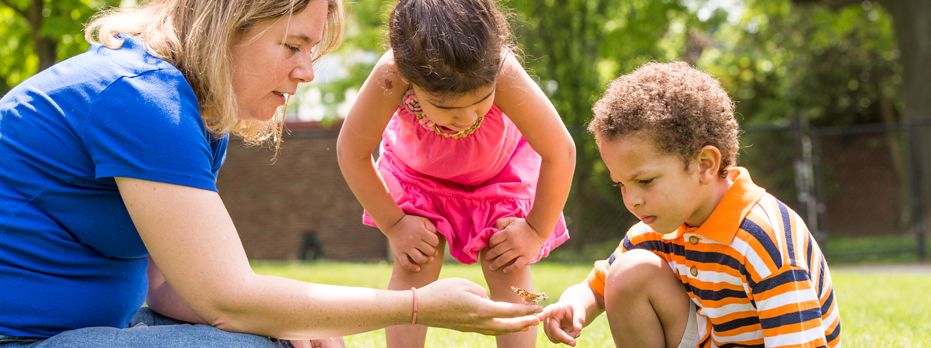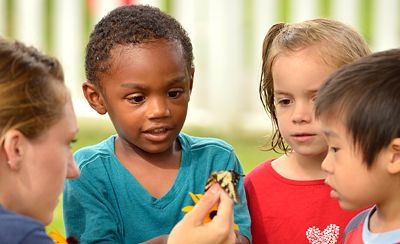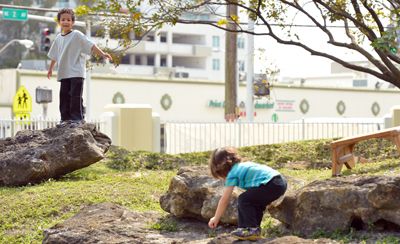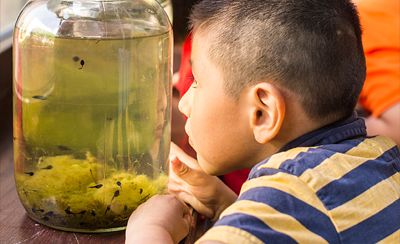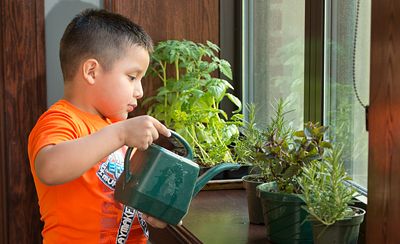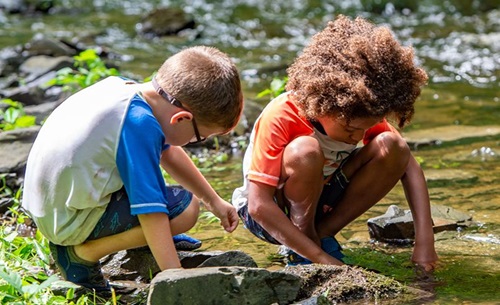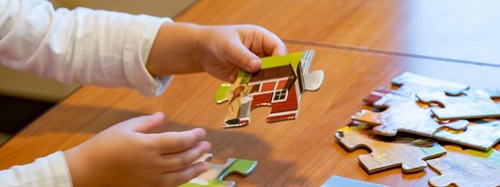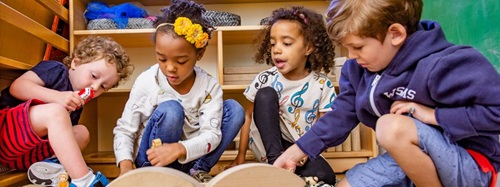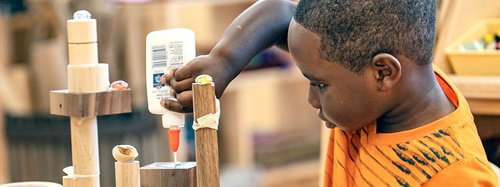Project Work and Nature
A Natural Combination
|
May 2013
A project is a deep investigation of something that interests children. Project work energizes and motivates children. It can transform classrooms into exciting learning laboratories where children begin to see how math and literacy skills can help them find answers to their own questions. In guiding project work, one of the most important decisions that you will make is the choice of a topic. A good place to look for project topics is in the outdoor world of nature.
Children’s connection with nature is rapidly diminishing just as we are beginning to realize how vital it is for their intellectual, emotional, social, and physical development. More and more educators and parents are becoming aware of the problems resulting from diminished contact with nature. Outdoor play has many benefits in early childhood, including improved concentration and impulse control, greater emotional coping and stress reduction, richer creative play, increased fitness and reduction in childhood obesity, and better resiliency. Just being outside, however, is not sufficient. Although we may provide playground space and play equipment, both are often devoid of contact with living or natural things. Many of these outdoor spaces—with their plastic and metal climbing equipment, rubber cushioning surface, and concrete wheeled-toy areas—are more like outdoor workout gyms than play areas.
Project work that investigates nature builds a totally different relationship between children and their natural world. Children benefit from experiences that connect them to parts of the environment that are self-sustaining like plants, animals, and habitats that function independently of human activity. When children investigate nature topics with supportive adults they become more comfortable in the outdoor world and are more willing and interested in spending time there.
The activities and events which occur in project work can make a unique contribution to connecting children with nature. As children do project work, they collect artifacts, study them closely, and represent what they learn by drawing, painting, constructing, writing, or even through play. Nature is highly stimulating and engaging, and invites study and deep thinking. Children form basic understandings of facts and terms, they learn the importance of differentiating words and develop rudimentary classifications, and they begin to develop a sense of cause and effect.
Nature provides many opportunities to learn the names of things, to extend their knowledge, and to learn to define precisely. For example, children studying a meadow will learn about the birds, flowers and plants that grow there—and about how they are alike and different. Instead of just learning the meaning of “tree,” they may also learn the differences between evergreens and deciduous trees. They may learn that crows are different from songbirds. They will have an opportunity to develop deep understanding—not just knowledge of isolated facts and identification but a sense of why things happen. For example, birds peck on trees to eat insects that live there. Snow falls from the sky only at certain temperatures. Butterflies fly but caterpillars do not.
Project work that is focused on nature also supports problem solving and creative thinking. How can we capture that dragonfly without hurting it? How can we make sure our plants get enough water? Just interacting with nature can provide challenges. As children focus their investigation on nature topics, they also learn that nature and a natural environment are interesting and valuable. They learn to be protective and supportive of the natural environment.
It is easy to find a nature topic. If you provide access and time for children to explore natural areas they will often see bugs, trees and other forms of nature. A topic will emerge as children discover items and bring them in or tell stories about their experiences. By listening carefully to children’s conversations, you can often detect a possible topic gaining momentum as a child shares something and interest grows among the other children. If you then spend some time building background knowledge with them, you can gauge the level of interest as they begin to explore the topic.
Some children have had few prior experiences with nature or have spent little time outdoors. If so they are less likely to exhibit an intense interest in a nature topic. They might actually be fearful of the outside environment. Fears may emerge as children encounter living things such as insects, snakes, toads, or even some plants. If a nature topic is unlikely to spontaneously emerge, the teacher may want to introduce a nature topic to the children.
Although many teachers believe that studying nature is impossible for their classroom because they are in a city location or have only blacktopped play spaces, there is almost always some nature in even the most urban environments. Teachers in downtown Chicago shared rich nature projects from their schools even when those schools were in urban environments and field trips were limited.
One way to find a possible nature topic is to survey the neighborhood around your center. This is especially effective if other teachers also participate. Each teacher takes a notepad and walks in a different direction from the school or center. Ten minutes walking away from the school, then 10 minutes walking back, should yield a good list of possible nature topics. (Ten minutes represents the distance that the class can walk without losing too much time in travel, when investigating the topic.) If each teacher shares his or her list with the group, everyone will benefit from the survey regardless of the direction they went.
The staff of one school in El Paso, Texas, did this walking survey, and a teacher discovered that just one block from the school, in a place where “gravel” yards were common, there was one lush and well-cared-for garden. She talked with the resident, who was an enthusiastic gardener and was interested in sharing his expertise with her children. Later she took the children on that same walk and let them “discover” the garden. This was the beginning of the Planting Project.
Bringing Nature Inside the Classroom
Another technique for encouraging projectsthat connect children with nature is to increase opportunities for direct contact with nature during the daily life of the classroom. A common method is to hang a bird-feeder near a window or to put out corn for squirrels.
One classroom of 4-year-olds was having a grand time collecting nuts that fell from a tree overhanging their play area. They piled their “finds” into buckets and left them outside by a classroom window. They were shocked the next day to see that the squirrels were enjoying a work-free lunch. The children stretched out on their tummies and watched the squirrels through the low windows of the classroom. Seeing an opportunity to deepen observation, the teacher gave them clipboards, and they began to sketch. As they sketched the hungry visitors, they started to ask questions, and soon the teacher guided them into a discussion about what they knew. Before long the Squirrel Project was going strong.
Bringing in frog eggs to "hatch" in your classroom is a classic Spring activity.
Windowsill gardening is an option if you don't have access to an outdoor garden.
When surveying an area for possible topics or taking a walk with children, be sure to look on the ground, even digging a little or turning over rocks, or give the children magnifying glasses to focus on the grass and the ground. Many successful projects have focused on earthworms and caterpillars as children discovered them in their natural habitat. Studying something much smaller than they are is a great way for young children to grow comfortable touching, looking closely at, and thinking about animals.
Remember, however, when selecting a nature topic for project work that successful implementation of the Project Approach requires that children take the lead and that their questions determine the direction of the project. It is more important that children experience initiating and shaping an investigation with their questions than that the topic remains on any particular subject. An investigation of worms may suddenly turn into an investigation of fishing!
Here are some nature topics that have met with success:
- Toddler: Leaves (in the fall), water, worms, mud and sand, planting a seed, flowers, rocks
- Prekindergarten: Cats, rabbits, gardening, birds, meadow, stream, woods
- Kindergarten and first grade: Meadow, gully, pond, llamas (in a lama farm near the school), chickens, the river, trees, birds, park, pets
Nature topics such as these could lead you and your children to embark on a wonderful adventure in the great outdoors. Project topics do not always have to be about nature or science. There are many topics in the man-made world that children find engaging such as stores and vehicles. However, if you feel that your children are not comfortable in the natural environment, you could try exploring some nature topics and hopefully at least one of these will result in a nature project. Your project may end up not only connecting your children with nature but also reinvigorating your own interest in the fascinating natural world.

